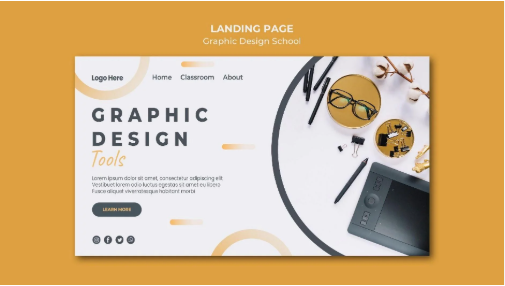As a graphic designer, your portfolio is your most important tool. It’s how you showcase your skills and creativity to potential clients. A well-designed portfolio can help you stand out in a competitive market.
Whether you’re just starting or updating your work, having a strong portfolio is key to attracting the right opportunities. In this post, we’ll share some tips to help graphic designers build a portfolio that makes a lasting impression and leads to success. Read on and learn more.
Understand Your Target Audience
Before designing your portfolio, know who you are creating it for. Think about the type of clients or companies you want to work with. This will help you tailor your work to match their expectations.
For example, if you want to be a logo designer, include more logo projects in your portfolio. If you aim to provide graphic design services to businesses, highlight projects like brochures and advertisements. A focused portfolio attracts the right kind of opportunities.
Showcase a Variety of Skills
Your portfolio should highlight your range of abilities. Include different types of work, such as branding, illustrations, and website designs. This shows that you are versatile and adaptable.
If you specialize in visual design, include projects that showcase your attention to detail and aesthetic sense. By demonstrating a broad skill set, you prove your ability to handle diverse client needs. Variety keeps your portfolio engaging and memorable.
Select Your Best Work
Quality matters more than quantity. Only include projects that you are proud of and that reflect your highest level of skill. Too much work can overwhelm potential clients.
Choose pieces that represent your unique graphic design ideas. Clients often judge your potential based on the examples you provide. A well-curated portfolio makes a stronger impact.
Tell the Story Behind Each Project
Add context to your projects by explaining the process behind them. Share what the client needed, how you approached the problem, and the final results. This adds depth to your work.
Clients love seeing the thought process behind graphic design artwork. It helps them understand your problem-solving skills and creativity. Stories make your portfolio more personal and relatable.
Keep Your Design Clean and Simple
Your portfolio should look professional and be easy to navigate. Use a clean layout with consistent typography and colors. Avoid clutter that distracts from your work.
A simple design ensures that your projects stand out. Remember, your portfolio reflects your style and professionalism as a graphic designer. Make it visually appealing and user-friendly.
Use High-quality Images
High-quality visuals are essential for a graphic design portfolio. Use clear, sharp images that show your work in the best light. Poor-quality images can make even great designs look unprofessional.
Invest time in photographing or digitally presenting your projects. Whether it’s a logo, a website mockup, or print materials, the presentation matters. High-quality images enhance your credibility and professionalism.
Include Testimonials or Client Feedback
Adding client reviews or testimonials to your portfolio builds trust. It shows that others have valued your work and were satisfied with your services. Positive feedback can make a big difference in attracting new clients.
Ask clients to share their thoughts on your graphic design services. A short quote about your reliability or creativity can go a long way. Testimonials add credibility and confidence to your portfolio.
Update Your Portfolio Regularly
Your portfolio should evolve as your career grows. Add new projects and remove outdated ones to keep it fresh. This shows that you are active and always improving.
An updated portfolio reflects your current skills and style. It’s also a great way to showcase recent trends in graphic design ideas. Regular updates ensure that your portfolio stays relevant and exciting.
Create an Online Portfolio
An online portfolio makes it easy for potential clients to view your work. Use a website builder to create a professional-looking site. Include your contact information and a link to your social media profiles.
If you’re short on time, you can collaborate with FreeUp freelancers to build your site. They can help you avoid costly mistakes and create a polished portfolio quickly. Having an online presence increases your visibility and accessibility.
Show Your Personal Projects
Including personal projects adds personality to your portfolio. These can be passion projects or experimental designs that showcase your creativity. They help potential clients see your unique style.
Personal projects are a great way to demonstrate skills that you might not use in client work. For example, if you enjoy creating graphic design artwork, include a piece that reflects your artistic side. Showing your passions makes you more relatable and interesting.
Highlight Results and Achievements
Whenever possible, showcase the results your designs achieved. Did your logo increase brand recognition for a client? Did your website design boost sales? Including measurable outcomes makes your work more compelling.
Add details about how your designs made a positive impact. It proves your value and effectiveness as a graphic designer. Highlighting results helps clients see why they should choose you.
Ask for Feedback and Revise
Feedback is a valuable tool for improvement. Share your portfolio with peers, mentors, or clients to get their input. Honest opinions can help you refine your presentation.
Use constructive criticism to make your portfolio even better. Sometimes, a fresh set of eyes can catch things you might have missed. This process ensures your portfolio is as strong as it can be.
Promote Your Portfolio
A great portfolio is useless if no one sees it. Share it on your website, social media, and professional networks. Include it in job applications and client proposals to increase your visibility.
You can also network with others in the industry to spread the word. Attend design events or join online communities to connect with potential clients. Promoting your portfolio actively brings more opportunities to your doorstep.
The Power of a Strong Portfolio for Graphic Designers
Building a strong portfolio is crucial for graphic designers. It showcases your skills and helps you stand out in a competitive market. By following these tips, you can create a portfolio that highlights your best work and attracts the right clients.
Remember to update it regularly and tailor it to your target audience. A well-crafted portfolio is the key to success for graphic designers looking to grow their careers and make lasting impressions.
Did you find this article helpful? Visit more of our blogs.







